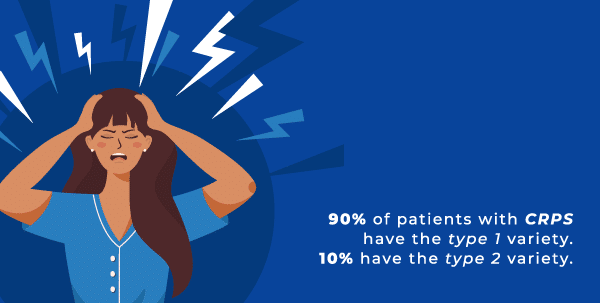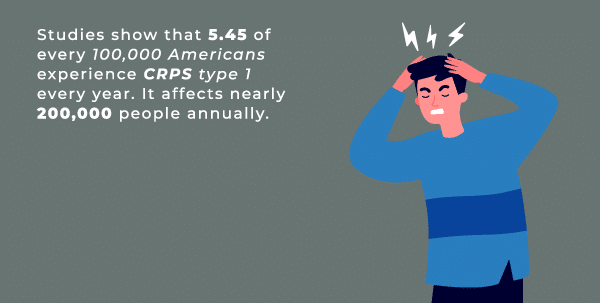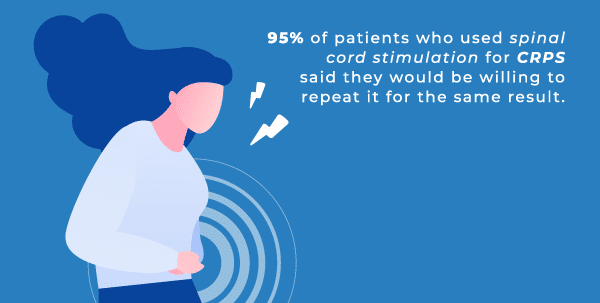

What Is Complex Regional Pain Syndrome
Use this in-depth guide to learn everything you need to know about complex regional pain syndrome.
Table of Contents
Complex Regional Pain Syndrome (CRPS)
For some people, pain is a part of life. Unfortunately, there are a variety of circumstances that can cause chronic pain that is difficult to treat. Complex regional pain syndrome (CRPS) is a chronic pain condition that is not clearly understood. It typically develops from a traumatic physical incident, such as an accident, surgery, stroke, or heart attack. CRPS can be difficult to deal with, but it is treatable.
The Types of CRPS
Complex regional pain syndrome involves an abnormality in the peripheral or central nervous system, commonly resulting from some sort of injury or trauma. There are two types of CRPS—CRPS-I (type 1) and CRPS-II (type 2).
Complex Regional Pain Syndrome Type 1 (CRPS-I)
Complex Regional Pain Syndrome Type 2 (CRPS-II)
Who Gets Complex Regional Pain Syndrome?
Now that we have a clearer answer to the question, what is CRPS, let’s take a look at who is at risk for developing the condition.
In addition, CRPS is more likely to occur in people who have been through a traumatic event, such as an accident, surgery, stroke, or heart attack.
A Further Look at CRPS
Stages of CRPS
Stage One (One to Three Months)
Stage one is defined as the acute phase and lasts approximately three months. During this stage, the most common CRPS symptom is burning pain that can limit function.
The pain is characterized by changes in the blood vessels that cause swelling and redness. Excessive sweating, coolness to the touch, and demineralizing of the bones due to inactivity are other CRPS symptoms experienced at this juncture.
Stage Two (Two to Six Months)
Stage Three (Multiple Years)
Symptoms of Complex Regional Pain Syndrome

Burning Pain
It is believed that CRPS affects the peripheral and central nervous systems. Nerve damage often leads to painful, burning sensations.
Sensitivity to Touch or Cold
Abnormal Sweating
People with CRPS may experience dysfunction of the sweat glands and blood vessels that can cause abnormal sweating.
Extreme Sensitivity to Pain
Skin in the affected area can get very sensitive to the point where even the slightest touch can cause extreme pain. This is also known as hyperalgesia.
Skin Swelling
Stiffness in Affected Joints
Motor Disability
The pain and stiffness complex regional pain syndrome causes can result in motor disability.
Muscle Spasms, Tremors, and Weakness
Changes in Hair and Nail Growth
Skin Changes
Causes of Complex Regional Pain Syndrome
Causes of CRPS vary greatly. Thus, to better understand this condition, become familiar with the factors and causes that lead to its development:
Fracture
CRPS can be caused by a forceful trauma to the arm or leg, such as a crushing injury or fracture.
Nerve Injury
Surgery
Burns and Cuts
Limb Immobilization
Infections
There are a variety of infections that can lead to the development of CRPS. These include the herpes virus, tuberculosis, mycobacterium, chlamydia, and more.3
Sprained Ankle
Even something as mild as a sprained ankle can cause CRPS. No one is sure of the reason for this connection, but it may be caused by the abnormal response due to the disuse or splinting of the foot and ankle.
Poor Nerve Health
Possible Complications of CRPS

- Chronic Edema: This is a severe swelling that can affect blood flow and cause ulcers to form on the skin.
- Neuropsychological Deficits: These include cognitive delay, language impairment, and disturbances in memory.
- Chronic Relapsing Infections: These are infections that occur repeatedly.
- Psychiatric Disorders: People with CRPS are prone to developing mental health issues, such as depression.
- Respiratory Complications: CRPS patients have been shown to experience shortness of breath and low lung volumes.4
- Autonomic Dysregulation: This occurs when the nervous system does not regulate properly. It can result in abnormal blood pressure, heart rate, and sweating.
- Dystonia: This is a movement disorder in which one or more parts of the body contract, causing involuntary repetitive twisting movements.
- Dermatologic Manifestations: These include edema, erythema, dermatitis, folliculitis, cutaneous atrophy, ulceration, and erythematous papules.
A Discussion on CPRS
How to Diagnose Complex Regional Pain Syndrome
Bone Scans and X-Rays
A bone scan will help find bone changes. It involves a radioactive substance injected into the veins, allowing the bones to be viewed with a special camera. X-rays can be used in conjunction with bone scans to show a loss of minerals that can occur in later stages of the disease.
Skin Sensitivity Test
Thermography
Thermography is a visual mapping of skin temperature recorded by a camera that’s sensitive to the infrared spectrum. It can detect if abnormalities in the nervous system are present.
Sweat Production Tests
Nerve Conduction Tests
A nerve conduction test is used to evaluate the function of the motor-sensory nerves in the body. It can be useful in diagnosing CRPS and other nerve-related diseases.
Magnetic Resonance Imaging (MRI)
An MRI uses imaging to form pictures of the body’s anatomy and functions. The images can show tissue changes that eliminate other conditions.
Available Treatment Options
Now that we have a pretty clear answer to the question, what is CRPS, we can begin talking about CRPS treatment. There is a range of treatment options and methods used to target each patient’s severity and type of complex regional pain syndrome:
Therapies
Multiple types of therapies can be used to treat complex regional pain syndrome, such as:
Physical or Occupational Therapy
Physical therapy for CRPS typically involves a stress-loading program. Active compression and distraction exercises stimulate the affected extremity without the need to move the joint. It may also include a scrubbing technique performed with a scrub brush.
Mirror Therapy
Mirror therapy is an effective complex regional pain syndrome treatment for patients experiencing more pain on one side of the body than the other. It involves using a mirror to create an illusion of the affected limb to trick the brain into thinking the movement occurred without pain.
Transcutaneous Electrical Nerve Stimulation (TENS)
Spinal Cord Stimulation
Spinal cord stimulation involves an implanted device that sends electricity to the spinal cord to relieve pain. 95% of patients who used the treatment for CRPS said they would be willing to repeat it for the same result.6
Heat Therapy
The application of heat may work as a complex regional pain syndrome treatment that relieves pain in some patients, but results vary.
Intrathecal Drug Pumps
Intrathecal drug pumps deliver medication directly to the cerebrospinal fluid to provide pain relief to spinal nerves. It serves as an effective CRPS treatment.
Medication for CRPS
Aside from therapy, different types of medication can help treat CRPS, including:
Pain Relievers
Corticosteroids
Steroid medications can reduce inflammation and increase mobility in the affected area.
Bone Loss Medications
Intravenous Ketamine
Sympathetic New Blocking Medication
Antidepressants
Antidepressants and anticonvulsants can sometimes be used to treat neuropathic pain.
Self-Care Tips for Manage CRPS

The right lifestyle activities and self-care strategies can help manage CRPS. They include:
Exercise Regularly
People with CRPS may find it difficult to exercise; however, the right exercises can be beneficial. Exercise can prevent the development of kinesiophobia, a fear of movement that sometimes develops in CRPS patients. It’s important to talk to a physical therapist to determine the exercises that work best before proceeding.
Take Vitamin C to Reduce Inflammation
Take an Epsom Salt Bath
Drink Bone Broth
Meditate
It is common for people with chronic pain conditions like CRPS to feel stress and anxiety. Unfortunately, these emotions can aggravate CRPS symptoms. Meditation is a complex regional pain syndrome treatment that can calm the body and mind, making pain and inflammation less likely to occur.
When Should You Get Medical Advice?

Sometimes, determining when to see a doctor can be difficult, especially if someone is struggling to identify their symptoms. If you or a loved one is experiencing constant severe pain that affects a limb and becomes intolerable if the area is touched or moved, do not hesitate to see a medical professional. The sooner treatment is received, the better the prognosis will be.
Get Help Today for CRPS
J. Flowers provides bespoke care to people of all occupations and ages, but we specialize in helping professionals and executives who don’t have a lot of time to focus on health and wellness. We also offer programs for teenagers.
We take a personalized approach and integrate a strategy for whole-body healing that accounts for both mental and physical health. We treat chronic pain disorders, such as CRPS, mental illnesses, addiction, eating disorders, and more.
Now that you know the answer to the question, what is CRPS, you have the information you need to take the next step and take hold of the condition. We understand it is not pleasant to live with complex regional pain syndrome, so we at J. Flowers Health are here to help you make it through. Contact us today to find out how you can achieve optimal wellness.
Resources
- https://rarediseases.org/rare-diseases/reflex-sympathetic-dystrophy-syndrome/
- https://www.ncbi.nlm.nih.gov/pmc/articles/PMC3644418/#:~:text=Immobilization%20in%20the%20setting%20of,of%20the%20syndrome%20is%20dynamic
- https://pubmed.ncbi.nlm.nih.gov/14998056/
- https://www.practicalpainmanagement.com/pain/complex-regional-pain-syndrome-systemic-complications?page=0,1#:~:text=A%20longitudinal%20retrospective%20study%20of,low%20lung%20volumes%20in%2017%25.&text=Only%201%20patient%20(0.5%25),of%20chronic%20obstructive%20lung%20disease
- https://pubmed.ncbi.nlm.nih.gov/24762157/
- https://www.ncbi.nlm.nih.gov/pmc/articles/PMC4168752/#:~:text=Spinal%20cord%20stimulation%20(SCS)%20seems,not%20already%20been%20implanted









